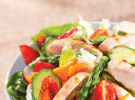The rather ironic thing about modern life is that as technology advances and as we busier and busier in our day to day life, we actually need less food, even if you are training for an hour each day.
How can that be? A number of factors make this rather harsh reality the case. First and foremost the less we move and the more time we spend front of a computer, the fewer kilojoules we burn. Secondly, the greater the number of modern appliances and power tools we use in house or yard work the fewer kilojoules we burn. Finally and perhaps most importantly, the foods we are eating have more kilojoules than ever before. So if your training gear is a little on the snug size (or at least more snug than usual), maybe it is time to do a portion check.
One of the most important things to consider when it comes to portion control is that eating – or more specifically overeating – becomes a habit that develops over time. One day you are happily ordering a small coffee and skipping the snack, and then a few months later your order has become a jumbo coffee with a muffin or slice of banana bread. Or an extra serve of meat at dinner, or the second afternoon tea you grab when you get home from work early. All these extras add up, and without even realising it you are eating an extra 300 to 500 calories each day, slowly gaining weight. In addition, your body is now used to eating much larger volumes of food on a daily basis. So how can you get a firm grasp of your own portion distortion and take control of your weight at the same time?
Well, let’s start with breakfast. It is known that basically we will eat the portions that are served to us. For this reason, measuring out just ¾ of a cup of breakfast cereal and serving it in a small shallow bowl, rather than a deep soup style bowl is imperative. In the case of toast, always buy loaves of bread with the smallest, thinnest slices. Remember that some types of bread will have almost double the kilojoules, as they are so much larger than the original 30g slices of the 1970s and 1980s. Next is your choice of coffee cup size. Generally coffee shops will offer regular sized cups which will contain at least an extra 100kJ compared to small cups. Always ask for small coffees and keep a count of how many milk based coffees you are drinking each day. One or two is fine, but if you are enjoying three or four lattes or flat whites, there could be 200 to 300 extra calories you do not need.
Now onto snacks. Individual sized portions of yoghurt, cheese and crackers are convenient ways to make sure you do not over serve yourself. Avoid large pack or tubs as the more you are served, the more you will eat, just because it is there. If you are craving something sweet, remember that the most pleasure is derived from your first few mouthfuls of food so just 1/3 or ½ a slice of cake or slice should be more than enough to satisfy any cravings.
At lunchtime remember that sandwiches purchased from sandwich bars can be up to double the amount of kilojoules you really need from your lunch, and hence you may only need to eat half a large sandwich with a piece of fruit to satisfy you. If you are making your lunch, a few crackers or a slice of flat bread is again often all you need to keep you full for another two to three hours. Other high risk foods that tend to be overeaten during the day include nuts (10 is a serve), avocado (¼ is a serve) and salad dressings (you only need a teaspoon!).
For your evening meal, try weighing your portions of meat to get a grasp on how much you are actually having. Women will need just 100 to 150g and men 150 to 200g of lean meat, chicken or fish. Serves of Atlantic salmon and steak can often be double this size. And finally your treats at night; tubs of ice cream and blocks of chocolate are asking for trouble. If you do enjoy a sweet treat at night always look for portion control servings of chocolate or ice cream, and stick to 400kJ or less to start to keep a tighter hold on your kilojoule intake in each meal, every single day. And the easiest way of all to trick your body into eating fewer kilojoules without realising it is to load your plate up with plenty of vegetables and/or salad. Not only are they literally kilojoule free, but packed with nutrition and will help to keep you full for a number of hours after dinner time.
Portion control when eating out
One of the biggest is issues to consider when it comes to portion control is that when we enjoy meals away from home, at a restaurant, café or even someone else’s home, that we are likely to consume at least 20 to 30% more calories. Extra oil, sauces and added fats via cheese and butter are just a few of the reasons. Added to this, relatively large serving sizes of meat compared to small serves of vegetables, extra bread and possibly coffee and dessert, such a feeding frenzy can easily give you 500 to 600 extra calories without even trying.
Take control of this by sharing large meals where possible.
Order extra sides of soup and salad to fill up on low calorie foods.
Order entrée sizes meals and do not be afraid to ask for leftovers to be packaged up to take home.
If you plan to have a couple of glasses of wine finish one before starting another, instead of topping up your glass.
Move the bread basket out of sight and reach.
Ask for extra sauces to be served on the side.
Practise eating only ½ of large serves of sandwiches.
Remove the lid from burgers and steak sandwiches.
Ask for chips to be replaced with salad.
Look for child serve options of burgers, sandwiches, ice creams and fish meals.
Practise becoming comfortable not eating everything on your plate.
Never arrive at a smorgasbord or food court hungry.
In you are dining out where there are large volumes of food readily available eg yum cha, decide how many serves you will eat before you get there. Such a mental rule makes it easier to stop eating.
Tip for portion control
1) Always measure breakfast cereal and rice/pasta serves using a measuring cup.
2) Keep kitchen scales handy to check meat portions and serving sizes.
3) Measure out sauces and oils rather than pouring haphazardly.
4) Purposely look for small slices of bread when shopping.
5) Use grated cheese or invest in a cheese slice to control portions.
6) Measure out serves of dip and cheese when serving platters.
7) Only carry portion controlled snacks of nuts and crackers.
8) Remember your plate ratios of ¼ protein, ¼ carbs and ½ vegetables or salad.
9) Serve desserts and treats in small bowls and glasses.
10) Always order a small or piccolo sized coffee.
Portions Visually
Meat = i-phone
Cheese = Pack of cards
Carbs = computer mouse
Bread = no bigger than your hand
Rice = Asian bowl
Wine = ½ teacup
Sauce = 20c piece
Baked chicken with spinach salad
Serves four
750g chicken breast, skin removed
2 cups buttermilk
2 tbsp. honey
1½ cups multigrain breadcrumbs
2 garlic cloves, finely chopped
4 cups baby spinach leaves
1 bunch cooked asparagus, cut into 3cm pieces
1 tbsp. olive oil
1 punnet cherry tomatoes
Balsamic vinegar
1) Slice chicken into strips and place with large bowl.
2) Whisk buttermilk, honey, garlic together and pour over chicken. Leave to marinate for at least 2hrs.
3) Remove chicken and coat with breadcrumbs and bake at 200ºC for 30-40 minutes.
4) While chicken is cooking, combine spinach leaves, asparagus, tomatoes and dress with olive oil and balsamic vinegar dressing.

